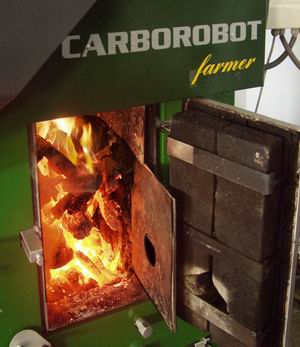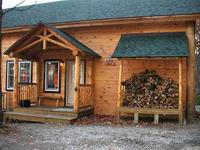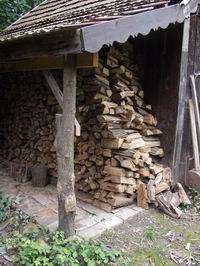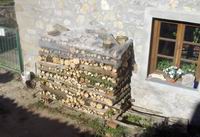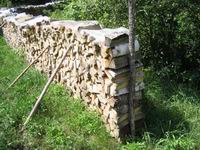Biomass
boilers
For
warm water
- BIO
Automated, pellet, wood chips,
- Farmer
Automated, pellet,wood chips,
wood logs, multifuel
- Automat
Self-loading, automated, pellet,
wood chips, multifuel
Steam boilers
- Low pressure steam (0,5bar) automated boilers
for biomass, pellet, wood chips, multifuel
Coal
boilers
- Automated brown coal boilers
For warm water or low pressure steam
Fuel
feeder systems
|
| Residential Wood Heating |
|
|
|
|
The logs are the traditional
form of wood fuel which can be easily stored, air dried and burnt
in a wide range of appliances from open fires to modern automated
boilers.
The advantages of logs are:
• they are readily available, although there are no guarantees of
quality so the buyer has to make sure they are suitable for the
proposed use.
• bought in bulk, they are the cheapest form of wood fuel;
• they are almost always locally produced, so buying logs benefits
local woodlands and the local economy.
The disadvantages of using logs are:
• there is no agreed quality standard, so logs may be the wrong
size or too wet
• using logs requires more involvement than other forms of wood
fuel, stoves have to be loaded and cleaned, and even highly efficient
modern boilers have to be loaded on a daily basis.
|
| Further informations
Firewood rating |
|
| Burn firewood in CARBOROBOT
|
|
|
|
|
The firewood we can use in CARBOROBOT
Farmer and CARBOROBOT Impulse boilers. This boilers have separate
gasification burning chamber to burn woo,
bio briquette and other solid chunky materials. The burning
process in the boiler occur in impulse mode. The firewood
burn with high speed and high power. This impulse mode allow burn
wood wery clean. The heat will be shepherd to the buffer
accumlator
The drier your wood is, the better and
cleaner it will burn, and the less creosote buildup you will have.
Your stove or chimney cleaning needs will not be as frequent, and
above all, you will limit yourself and your family to the minimum
risk of having a chimney or stove fire. Wood ash does not contain
nitrogen. The largest component of wood ash (about 25 percent) is
calcium carbonate, a common liming material that increases soil
alkalinity. Wood ash has a very fine particle size, so it reacts
rapidly and completely in the soil. Although small amounts of nutrients
are applied with wood ash, the main effect is that of a liming agent.
Applying small amounts of wood ash to most soils will not adversely
affect your garden crops, and the ash does help replenish some nutrients.
But because wood ash increases soil pH, adding large amounts can
do more harm than good. You can apply wood ash at low rates to a
garden usually lower than 20 lbs per 1000 sq ft (five gallon pail)
with few detrimental effects. NEVER treat firewood with any
type of pesticide. When you burn the wood, toxic fumes could be
produced.
You should only burn clean, uncoated, non-salt-laden, untreated
wood. Don't burn painted, stained, creosote treated wood
or wood that has been pressure treated with preservatives (these
usually tint the wood green or brown). Most shipping wood is treated
with one or more of the following: fire retardant; insecticide;
fungicide. The arsenic treatments were easy to spot being green...now
copper compounds are used. Insecticides are not easy to detect.
Fire retardants result in a brownish or rust colored stain. We have
noticed that sometimes even stickers (for under bunks of lumber)
are treated. Newspaper logs, particularly using the copper sulfate
and salt concoction you mention, would give off toxic emissions
certainly laced with dioxin since dioxin is produced during the
combustion of organic material, especially in the presence of salt.
Dioxin is a persistent, bioaccumulating toxin. You don't want dioxin
emissions in your neighborhood.
Don't burn plastics, PE or PVC bottles, paints, waste oil vele.
Further informations CARBOROBOT Farmer
|
|
|
|
| Measure of firewood |
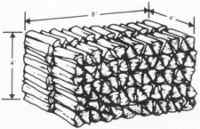

Conversions:
1 cord = 128 cubic feet (ft3)
8' x 4' x 4' stack of wood = 1 cord
half cord = 1/2 cord = 64 cubic feet
quarter cord = 1/4 cord = 32 cubic feet
1 stere = 1 cubic meter (m3) = ~0.276 cords
|
|
|
What is a Firewood Cord?
Firewood sales terminology is explained here!
Firewood cord? If you're like me, the first time you try to buy
firewood, you are confused about all the terminology. In the US
most large lots of firewood are described as a cord or some part
of a cord, such as a half cord or quarter cord. What are these measurements
and how do we compare them to smaller amounts? For example, at my
local grocery store, they have firewood sales which are small bundles
of wood that are 0.9 cubic feet of almond wood each. It would be
nice to be able to compare this 0.9 cubic feet to a cord to see
if I am paying a fair price.
Below are some terms and conversions explained for a firewood cord
and other frequently used measurements in firewood sales. Generally,
firewood measurements are based on a volume of wood, as in the cord
or stere:
Firewood cord: A cord is a measure of firewood
which is used pretty much throughout the United States. A cord equals
128 cubic feet (ft3) which is the same as a wood pile of 4 foot-long
logs stacked 8 feet wide and 4 feet high (8' x 4' x 4'). This is
the most commonly used measurement for firewood sales in the US
although be careful to not confuse it with a "face cord"
as described below. Many firewood sales are based on smaller units
than the cord. For example, it is common to sell half cords or quarter
cords. A half cord is simply 1/2 the volume of a full cord while
a quarter cord is 1/4 the volume of a firewood cord. Therefore 2
half cords equals one cord and 4 quarter cords equals one cord.
Face cord: In some areas you may see wood labeled
as a face cord, rather than a firewood cord. This is not legally
defined and varies from one area to another. The size of these "face
cords" can vary tremendously! So be careful when buying wood
and make sure you are getting prices for a true firewood cord and
not a smaller face cord.
Firewood bundle: It is common to see smaller boxes
or bundles of woods at local supermarkets or home supply warehouses.
These are not regulated and you have to look at each shipper's packaging
to determine the amount of wood contained within. In my area, it
is most common to see 0.9 cubic foot bundles, but I've also seen
up to 1.5 cubic foot bundles. To determine the price per cord, you'll
need to use the conversion from cubic feet to firewood cord.
Metric system (stere): In the metric system (not
often used in the US but commonly in Europe, Canada and other countries),
firewood sales are not based on a firewood cord and are rather based
on the stere. The stere is one cubic meter (1 m3) which is roughly
~0.276 cords.
Australia (tonne): In Australia, firewood is not
sold as a firewood cord, it is sold by the tonne. A tonne is a measurement
of weight, not volume as the stere and firewood cord are, so it
is not exactly easy to convert. The conversion from cord to tonne
will depend on the density of wood as some woods are heavier than
others per unit of volume.
|
|
|
|
| Splitting the differences
in firewood types |
|
|
|
A Mike McClintock Special to The Plain
Dealer
Burn wood occasionally and you can tolerate extravagant
prices on little bundles at the supermarket. Burn wood more often
and you'll need to buy larger quantities. And as fuel prices continue
to escalate, many people are doing just that. A recent survey by
the Emerson Electric Co. found that almost 25 percent of homeowners
are supplementing their central heating with wood and other alternative
energy sources.
But buying firewood can get complicated. There are full cords, face
cords and fireplace cords, plus seasoned versus unseasoned and hardwood
versus softwood. Here are nine ways to sort through the options.
Full cords. A true cord is a stacked, unsplit pile that measures
4 feet by 4 feet by 8 feet - a practical size that dates from Colonial
times. According to the New Hampshire Agricultural Extension Service,
Colonials cut firewood in 4-foot lengths because it was a size people
could handle. They stacked the logs in 8-foot piles because that
was about all a team of horses could haul.
Face cords. The amount varies because this term refers only to the
face of a 4-by-8-foot stack. A face cord of 2-foot logs for a large
fireplace is half the depth of a full cord and therefore about half
a cord. A face cord of 12-inch logs for a small wood stove is one-quarter
the depth and therefore about one-quarter of a cord.
Fireplace cords. This measure is based on a 4-by-8-foot stack cut
to standard burning length of 16 inches. That's one-third the 4-foot
depth of a full cord, so you're getting about one-third of a cord.
Split cords. Split wood nestles more closely together than full
logs. Cut to 16 inches, a split pile is about 15 percent smaller
than the same wood stacked unsplit. Cut to 12 inches, a split pile
can be about 25 percent smaller.
Dumped wood. It's difficult to judge a jumble of logs dumped in
the driveway. So on your first order from a firewood dealer, consider
paying extra for stacking. If you're buying hardwood you'll be able
to spot pine or other softwoods padding out the load. Once the wood
is stacked, you'll also see if you got the amount you paid for.
Box stacking. Open, box-pattern stacking makes sense if you're storing
unseasoned wood to air dry. But to judge cord size, logs should
be nestled together. If you're buying seasoned wood for burning,
don't let a supplier box stack. It can pack out the pile by 50 percent.
Wood by weight. Selling wood by weight instead of by the cord is
another blind alley. Even if the supplier has a scale that can calculate
tons, you sure don't so there's no way to check. Also, the weight
of wood varies a lot. Dense hardwoods can weigh 4,000 pounds or
more to a cord while a cord of softwood, such as white pine or aspen,
often weighs half as much.
Hardwood vs. softwood. Hardwood is more dense than softwood, or
taken another way, there's more wood inside - and more heat. A cord
of softwood often contains 10 million to 15 million BTU's, but the
same volume of hardwood often contains over 20 million BTU's. Hickory,
white oak, red oak, maple and other hardwoods cost more, of course.
But they also burn cleaner (producing less creosote) and burn longer
so you don't have to feed the fire as often as you do with softwood.
Seasoned vs. unseasoned wood. Whatever wood you buy - hard, soft,
cut, split - you'll get hassles instead of heat unless it's seasoned.
That means stacked to dry, generally for at least a year and longer
for some hardwoods. (After four or five years, most cut logs start
to deteriorate - and sooner if they're not protected from the weather.)
Seasoning has such an impact on heat that you would be better off
with a cord of softwood that's dry than a cord of hardwood that's
green. Recently cut wood can be more than one- third moisture by
weight; and when green wood burns, a lot of its potential energy
is consumed, converting that moisture to water vapor instead of
heat. You could split open a log to see if the wood grain inside
is wet or dry. But you can spot unseasoned wood by its tight-fitting
bark and spongy end grain. Seasoned wood generally has looser, more
brittle bark and a spider-web pattern of drying marks on the ends
of the logs.
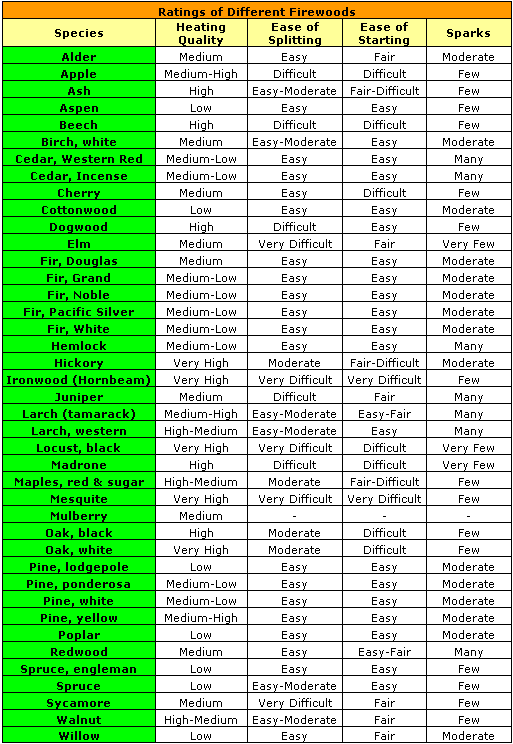
| Firewood
Seasoning (drying) |
|
Firewood Seasoning (drying) - Most of us that live
in the city buy our firewood from a firewood sales specialist who
supplies pre-seasoned wood. Seasoned firewood is dried out (often
up to a year or more) so that it lights easier and burns hotter.
Wet or "green" wood is not as good for building a fire.
However, if you have access to fresh wood which has just been chopped,
you can use your firewood rack to season your wood yourself.
The same principles apply to other wood storage, but it is even
more important to keep your wood well insulated from ground water,
termites and rain. You can use your regular storage rack but make
sure the wood is not touching the ground and that there is as much
airflow around your wood as possible. The airflow will help to dry
out the wood faster. Ideally, fresh wood should sit in this condition
for a year to be fully seasoned. However, after several months,
most wood is okay to burn but may be a bit harder to light and will
not give off as much heat. Remember, when you burn wood, the energy
of the fire goes first to burning off the water in the wood! Only
the energy that is left after this is what is given off as heat.
Stack your wood off the ground in an unheated shelter to help control
insects. Store little or no firewood in the house.
|
|
|
|
|



